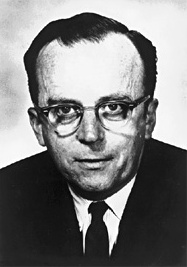Source: Wikipedia, Aug 2019
Licklider became interested in information technology early in his career. His ideas foretold of graphical computing, point-and-click interfaces, digital libraries, e-commerce, online banking, and software that would exist on a network and migrate wherever it was needed. Much like Vannevar Bush‘s, Licklider’s contribution to the development of the Internet consists of ideas, not inventions. He foresaw the need for networked computers with easy user interfaces.
Licklider was instrumental in conceiving, funding and managing the research that led to modern personal computers and the Internet. In 1960 his seminal paper on “Man-Computer Symbiosis“[23] foreshadowed interactive computing, and he went on to fund early efforts in time-sharing and application development, most notably the work of Douglas Engelbart, who founded the Augmentation Research Center at Stanford Research Institute and created the famous On-Line System where the computer mouse was invented.

Related Resources:
http://iae-pedia.org/J.C.R._Licklider, date indeterminate
Licklider at DARPA
DARPA (Department of Defense Advanced Research Projects Agency)has provided leadership and funding in a number of world-changing projects.
Quoting from http://www.nationmaster.com/encyclopedia/J.C.R.-Licklider:
In October 1962 Licklider was appointed head of the DARPA information processing office, part of the United States Department of Defense Advanced Research Projects Agency. He would then convince Ivan Sutherland, Bob Taylor, and Lawrence G. Roberts that an all-encompassing computer network was a very important concept.
When Licklider began his work at ARPA, there were no Ph.D. programs in computer science at American universities. ARPA began handing out grants to promising students, a practice that convinced MIT, Stanford, University of California at Berkeley, and Carnegie Mellon University to start their own graduate programs in computer science in 1965. This is certainly one of Lidlicker’s most lasting legacies.
SCIHI.Org, Mar 2019
During his active years in computer science, Licklider managed to conceive, manage, and research the fundamentals that led to modern computers and the Internet as we know it today.
His 1960 scientific paper on the Man-Computer Symbiosis was revolutionary and foreshadowed interactive computing. This inspired many other scientists to continue early efforts on time-sharing and application development. One of the scientists funded by Licklider’s efforts was the famous American computer scientist Douglas Engelbart, whose efforts led to the invention of the computer mouse.[4]
In August 1962, in a series of memos, Licklider described a global computer network that contained almost all the ideas that now characterize the Internet.
With a huge budget at his disposal, he hired the best computer scientists from Stanford University, MIT, UCLA, Berkeley and selected companies for his ARPA research. He jokingly described this approximately a dozen or so researchers, with whom he had a close exchange, as the “Intergalactic Computer Network“.
About six months after starting his work, he distributed an opinion in this unofficial panel, criticizing the problems of the proliferating multiplication of different programming languages, debugging programs and documentation procedures and initiating a discussion on standardization, as he saw this as a threat to a hypothetical, future computer network.
